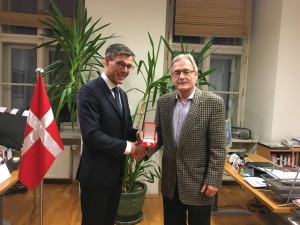Knight’s Cross of First Class of the Order of Dannebrog
Janusz Kahl, CEO in South Poland Cleantech Cluster and Consul of Denmark in Southern Poland (Małopolska, Śląskie, Podkarpackie and Swiętokrzyskie) with its registered office in Krakow, received on 28.01.2016 from the Ambassador of Denmark, HE Mr. Steen Hommel the Knight’s Cross of First Class of the Order of Dannebrog bestowed by Her Majesty the Queen Margrethe II for his civil merits.
Earlier on 24.10.2014 Janusz Kahl received from the Ambassador of Sweden, HE Mr Staffan Herrström Order of the Polar Star (Kungliga Nordstjärnenorden) assigned by HM King of Sweden Karl Gustav VI to the consul for his civil merits.

The Order of the Dannebrog (Danish: Dannebrogordenen) is an Order of Denmark, instituted in 1671 by Christian V. Until 1808, membership in the order was limited to fifty members of noble or royal rank who formed a single class known as White Knights to distinguish them from the Blue Knights who were members of the Order of the Elephant.In 1808, the Order was reformed and divided into four classes, with the ranks:• Special class
Grand Commander (Storkommandør) — wears the badge with diamonds on a necklet (gentlemen) or on a bow (ladies), plus the star on the left chest;
• First Order class
Grand Cross (Storkors) — wears the badge on a collar or on a sash on the right shoulder, plus the star on the left chest;
• Second Order class
Commander 1st Class (Kommandør af 1. grad) — wears the breast cross on the left chest, plus (for gentlemen) the badge on a neck ribbon;
Commander (Kommandør) — wears the badge on a neck ribbon (gentlemen) or on a bow (ladies);
• Third Order class
Knight 1st Class (Ridder af 1. grad) — wears the badge on a ribbon (gentlemen) or on a bow (ladies) with rosette on the left chest;
Knight (Ridder) — wears the badge on a ribbon (gentlemen) or on a bow (ladies) on the left chest.
The Grand Cross can, as a special honor, be awarded “with diamonds”. There is also a Cross of Honour (D.Ht.) (Dannebrogordens Hæderstegn).The Grand Commander class is reserved to persons of princely origin. It is only awarded to Royals with close family ties with the Danish Royal House. The statute of the Order was amended in 1951 by a Royal Ordinance so that both men and women could be members of the Order.
Today, the Order of the Dannebrog is a means of honouring and rewarding the faithful servants of the modern Danish state for meritorious civil or military service, for a particular contribution to the arts, sciences or business life or for those working for Danish interests.
The Order of the Polar Star (Swedish Nordstjärneorden) is a Swedish order of chivalry created by King Frederick I on 23 February 1748, together with the Order of the Sword and the Order of the Seraphim.
The Order of the Polar Star was until 1975 intended as a reward for Swedish and foreign “civic merits, for devotion to duty, for science, literary, learned and useful works and for new and beneficial institutions”.
Its motto is, as seen on the blue enameled centre of the badge, Nescit Occasum. This is Latin and means “it knows no decline”. This is to represent that Sweden is as constant as a never setting star. The Order’s colour is black. This was chosen so that when wearing the black sash, the white, blue and golden cross would stand out and shine as the light of enlightenment from the black surface. The choice of black for the Order’s ribbon may also have been inspired by the black ribbon of the French Order of St. Michael, which at the time the Order of the Polar Star was instituted was also awarded to meritorious civil servants. At present, the ribbon of the Order is blue with yellow stripes near the edges (i.e., the national colors, but the reverse of the Order of the Sword’s yellow tibbon with blue stripes near the edges). Women and clergy men are not called knight or commander but simply as Member (Ledamot).
After the reorganization of the orders in 1975 the order is only awarded to foreigners and members of the royal family. It is often awarded to foreign office holders (such as Prime and Senior Ministers) during Swedish state visits. It is also awarded to junior members of royal families who would not qualify for the more prestigious Royal Order of the Seraphim.


